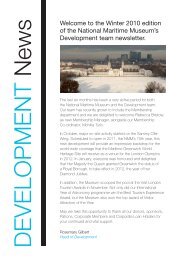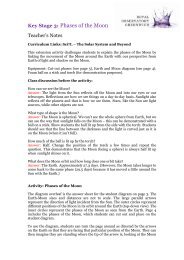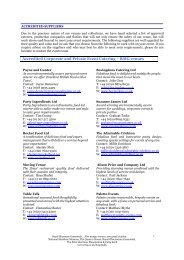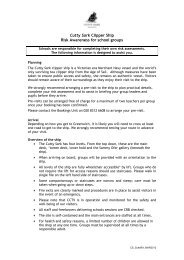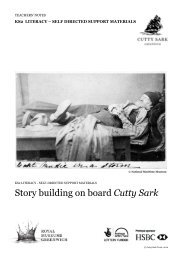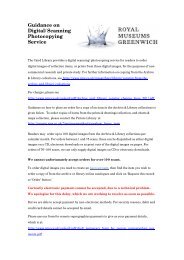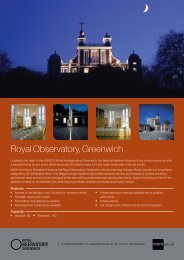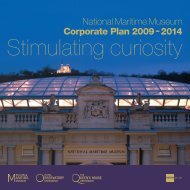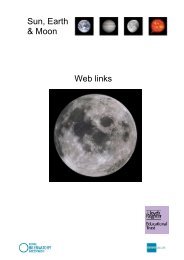The Volunteer - National Maritime Museum
The Volunteer - National Maritime Museum
The Volunteer - National Maritime Museum
You also want an ePaper? Increase the reach of your titles
YUMPU automatically turns print PDFs into web optimized ePapers that Google loves.
<strong>The</strong> <strong>Volunteer</strong> January 2012 - Issue 8<br />
<strong>The</strong> <strong>Volunteer</strong><br />
Ping Wo<br />
Life in the Day<br />
and much more...<br />
Helen Webb, <strong>Volunteer</strong> Manager<br />
Royal <strong>Museum</strong>s Greenwich<br />
Greenwich, London, SE10 9NF<br />
Phone: 020 8312 6543/ 020 8312 8571<br />
1
Editorial<br />
Welcome to the 8th issue of your<br />
newsletter which is coming out at the<br />
dawn of 2012: a year which promises to<br />
be a very exciting one for this <strong>Museum</strong>.<br />
First off we have our name change. We<br />
are now the Royal <strong>Museum</strong>s Greenwich.<br />
This change has come about as part of<br />
our re-branding and reflects the royal<br />
status which is due to be conferred on<br />
the London Borough of Greenwich next<br />
month. <strong>The</strong> <strong>Museum</strong>s referred to in our<br />
name are the Royal Observatory, the<br />
Queen’s House and the main maritime<br />
galleries. <strong>The</strong>se galleries will retain the<br />
name of the <strong>National</strong> <strong>Maritime</strong> <strong>Museum</strong>.<br />
As with our last issue, our front cover<br />
carries a reminder of the annual<br />
<strong>Volunteer</strong>s’ Seminar and Lunch which<br />
took place last May. Since then the<br />
<strong>Museum</strong>’s <strong>Volunteer</strong> Programme has<br />
continued to grow and the details are<br />
given, as usual, in this newsletter.<br />
Some of you kindly sponsored my<br />
colleague Rachel Mentiply as she<br />
undertook the Great Glen Way walk last<br />
autumn. She raised £943.83 for Guide<br />
Dogs for the Blind.<br />
Here is her report of<br />
her journey and a<br />
picture of her guide<br />
dog Samson, who is<br />
an important part of<br />
the <strong>Volunteer</strong> Office team.<br />
“It seems a long time ago now that<br />
Samson and I walked the Great Glen<br />
Way, a walk that I thought was going to<br />
be just 74 miles…However, the distance<br />
was calculated by a friend (not me!), as if<br />
we were going to do the walk via the<br />
roads. By the time we walked over<br />
mountains, or Glens as the Scots like to<br />
call them, doubled backward and<br />
forward walked a mile or two to the left<br />
or right we clocked up just over 100<br />
miles in four and a half days!<br />
Both my friend & I really enjoyed the<br />
challenge of the walk and Samson loved<br />
it. It was a holiday for him as well as he<br />
wasn’t in his harness and got to go<br />
swimming in the Lochs and running all<br />
day long!”<br />
With thanks for all you do and best<br />
wishes for the year ahead -<br />
Helen Webb<br />
<strong>Volunteer</strong> Manager<br />
East Wing, RMG<br />
020 8312 6543<br />
hwebb@rmg.co.uk<br />
2
A Life in the Day of<br />
Amaya Wang<br />
Can you tell us what your role is<br />
and what you do?<br />
Right now I’m volunteering in two roles;<br />
I’m a Queen’s House Room Guide and<br />
an Oil Painting Research <strong>Volunteer</strong>. I<br />
recently started the research role and am<br />
enjoying it a lot. <strong>The</strong> main thing I am<br />
doing is reviewing<br />
catalogue entries for<br />
the Digital Archive. We<br />
use spreadsheets a lot,<br />
comparing those to the<br />
hard copies, to make<br />
sure there are no<br />
missing dates, artists,<br />
spelling mistakes,<br />
wrong information or<br />
mistakes in dates. If<br />
there is something<br />
missing or incorrect<br />
and we cannot find the<br />
correct information we<br />
have to ensure that it is noted so that<br />
when the next volunteer comes in they<br />
know what’s what.<br />
How would your typical day pan<br />
out?<br />
I usually get in at ten o’clock, log into the<br />
computer and MIMSY system and then<br />
spend the day going through all the<br />
records ensuring that everything is<br />
correct... It’s really important as in the<br />
future these records will go online in<br />
conjunction with the BBC, so that people<br />
can access paintings that aren’t seen<br />
because they are in storage. Hopefully it<br />
will encourage more people to visit the<br />
<strong>Museum</strong> once they’ve seen online what<br />
the <strong>Museum</strong> has.<br />
Why did you decide to volunteer<br />
here?<br />
I’ve always been interested in history, art<br />
and architecture, as I live and have<br />
studied nearby I thought what a great<br />
way to learn more and get a real physical<br />
sense and feel of that history and drama!<br />
What did you study?<br />
I did a degree in Dance and then a<br />
Masters in <strong>The</strong>atrical Studies. Although<br />
it doesn’t instantly sound like they<br />
match with museum work, I’ve found<br />
that they do help. I like to try to combine<br />
performance with an object. <strong>The</strong> dance<br />
has also helped me to be<br />
disciplined in the research<br />
role.<br />
What do you enjoy most<br />
about your role?<br />
I really enjoy using my brain<br />
in a way you don’t when<br />
you’re dancing, you have to<br />
be really careful not to make<br />
mistakes and have a real<br />
attention for detail.<br />
What would you like to<br />
be doing in five years<br />
time?<br />
I want to stay in London. Everything<br />
about London draws me to it. <strong>The</strong><br />
history, the drama, the culture, the arts,<br />
the buildings and the restaurants. One<br />
day I would love to curate an exhibition,<br />
including dance, performance, objects<br />
and art! I think I would enjoy the<br />
challenge and process of doing such a<br />
thing. In the end I would like to work in<br />
cultural heritage, and my volunteering<br />
here is helping me to gain some much<br />
needed experience.<br />
Amaya was talking to Rachel Mentiply<br />
late last year. <strong>The</strong> project Amaya was<br />
volunteering for at that time has now<br />
been successfully completed.<br />
3
Summary of volunteer<br />
activity<br />
Here’s the usual summary of the Programme<br />
as at December 2012. We now have 242<br />
volunteers, with several people volunteering<br />
for more than one role:<br />
Directorate (15)<br />
Assisting in the Press Office and Membership<br />
Office. Helping to sell Membership of the<br />
<strong>Museum</strong> to visitors. Researching the<br />
<strong>Museum</strong>’s history to create a database of<br />
statistics and other information.<br />
Collections (16)<br />
‘Cleaning up’ entries on the Collections<br />
database. Listing and ‘housing’ paper-based<br />
material. Assisting in the Textile Studio.<br />
Creating boxing and protective sleeves for<br />
paper objects. Listing, organising and<br />
researching the ship plans and other Brass<br />
Foundry collections.<br />
Research & Planning (46)<br />
Assisting readers on arrival in the Caird<br />
Library—specifically with readers passes.<br />
Drafting additional text for the ship portrait<br />
catalogue. Assisting with work on the<br />
<strong>Museum</strong>’s archives. Helping to sort modern<br />
records.<br />
Royal Observatory, Visitor Experience &<br />
Communications (124)<br />
Conducting escorted tours for visitors and<br />
helping with events, such as Evenings with the<br />
Stars. Assisting with administration & other<br />
tasks. Assisting in the Horology Department.<br />
Winding the clocks at the weekends.<br />
Being a Visitor Support <strong>Volunteer</strong> & assisting<br />
in a variety of ways such as welcoming tourists<br />
off the river boats & in Greenwich (seasonal),<br />
assisting visitors in the Compass Lounge &<br />
assisting staff as they welcome visitors to the<br />
Sammy Ofer Wing and Royal Observatory.<br />
Conducting 25 minute escorted tours of the<br />
Queen’s House and Neptune Court. Helping to<br />
welcome visitors to the Queen’s House as a<br />
Queen’s House Room Guide.<br />
Operations & Human Resources (5)<br />
Assisting in the <strong>Volunteer</strong>s Office and in HR<br />
department.<br />
<strong>National</strong> Historic Ships (2)<br />
General administrative support.<br />
Youth Advisory Group (22)<br />
Joining a group which gives young people a<br />
voice in the <strong>Museum</strong>.<br />
Exhibitions & Programmes (30)<br />
Assisting the Family Programme with<br />
children’s events. Assisting the Adult<br />
Programme with their events. Joining the<br />
Envelope Team and responding to ad hoc<br />
requests for help with large mail outs.<br />
[Launching soon - Sea and Me volunteers—<br />
recounting maritime experiences.]<br />
4
<strong>The</strong> Voyage of the<br />
Ping Wo<br />
<strong>The</strong> Ping Wo (‘Equitable Harmony’ in<br />
Mandarin) was a flat bottomed river steamer<br />
of 3105 tons, built in China in 1922, which<br />
had operated on the Yangtze River between<br />
Chongqing and Shanghai before she found<br />
her way to Singapore.<br />
How and why she arrived there in 1941, I<br />
have been unable to discover. She was<br />
requisitioned in December 1941 by the Royal<br />
Navy and used to tow the destroyer HMAS<br />
Vendetta, which was refitting there, to<br />
Australia at 3 knots. She was then<br />
commissioned by the Royal Australian Navy<br />
in May 1942 and operated throughout the<br />
Pacific War in a variety of roles.<br />
In 1946 the RAN planned her return to the<br />
pre-war owners and it was in April that year<br />
that I had my first sight of her in Sydney<br />
Harbour. I was one of a Royal Navy party<br />
drafted to take passage in her to Hong Kong,<br />
and as we boarded her the C.P.O. of the<br />
regular RAN crew opined that it was very<br />
unlikely we would complete the voyage. Given<br />
that she had been described as a ‘clapped out<br />
rust bucket’ by her first C.O. it was easy to<br />
understand his pessimism, and mine! Our<br />
sailing was delayed for 11 days till a cyclone<br />
passed and we finally left on 20 April. It<br />
would take much more space than I have here<br />
to detail all the incidents encountered on the<br />
voyage, but this brief narrative includes some<br />
of them.<br />
A severe leakage in our water tank developed<br />
immediately and we put into Brisbane for<br />
repairs. We then sailed, first to Townsville<br />
and then on to Thursday Island off the tip of<br />
NE Australia. We had to anchor every night<br />
as the bridge compass developed a fault,<br />
and there were obvious navigational<br />
problems proceeding through the dangerous<br />
Barrier Reef.<br />
After an interesting stay at Thursday Island,<br />
where I met some pearl divers, one of whom<br />
had lost a leg to a shark, we wallowed across<br />
the Gulf of Carpentaria to Darwin in a heavy<br />
swell. <strong>The</strong> noise of the sea smashing up<br />
against the sponsons was an unpleasant<br />
accompaniment to our progress,<br />
compounded by water flooding into the after<br />
-hold through a cargo door on the waterline.<br />
To our relief a shipwright on board was able<br />
to cement the door, but soon after this our<br />
steering gear broke down and we had to<br />
drop anchor for the night 50 miles from<br />
Darwin while repairs were effected. Darwin<br />
itself at that time was a small town, still with<br />
heavy bomb damage left over from Japanese<br />
air raids in 1942.<br />
Our progress from there across the Timor<br />
Sea was interrupted when a rating on board<br />
developed acute appendicitis and we had to<br />
turn back, racing for 7 hours at 12 knots to<br />
meet the cruiser HMS Euryalus, which had<br />
fortunately just left Darwin for Sydney and<br />
which sped north at her maximum speed. As<br />
our normal designed speed was a rarely<br />
obtained 10 knots it felt as though Ping Wo<br />
would be shaken to pieces in this dash<br />
which, however, had a happy outcome with<br />
the rating having a successful operation after<br />
being transferred to Euryalus.<br />
Our passage through the Flores Sea was very<br />
scenic, with a long string of volcanic islands<br />
visible, some rising to 5000 feet. Many shore<br />
navigational lights in these waters were still<br />
missing at this time and as a result one night<br />
we nearly ran aground on an island.<br />
5
Proceeding through the Celebes Sea we<br />
planned to call at Makassar but were warned<br />
off by the Port Authority as the area still had<br />
magnetic mines about and Ping Wo naturally<br />
had no degaussing gear to deal with these. We<br />
had therefore to proceed to Tarakan for<br />
urgently needed supplies as we were virtually<br />
out of water, and other stores were running<br />
very low, but there were some hours of<br />
tension till we were well out to sea again.<br />
Tarakan, then in Dutch Borneo, had many<br />
signs of defences erected during the Japanese<br />
occupation. After some difficulty we secured<br />
just enough water to last till our next port,<br />
Manila.<br />
Our passage there through the Sulu Sea was<br />
happily made in calm conditions and a 4 day<br />
stay in Manila was full of interest, including<br />
the old walled Spanish city, a sharp contrast<br />
to aspects of the American occupation. I<br />
counted over 90 wrecks in the harbour still<br />
waiting to be cleared. We sailed on the last leg<br />
of the voyage to Hong Kong still very low on<br />
water and stores, having had replenishment<br />
problems again. We then encountered the<br />
roughest seas of the whole voyage, and<br />
we rolled so heavily at times that I thought<br />
we might turn right over and fulfil the<br />
gloomy forecast we heard when we joined<br />
the vessel.<br />
My relief when we finally entered Hong<br />
Kong harbour on 8 June can be imagined. I<br />
arrived weeks later than scheduled on 29<br />
June at my final destination, the Japanese<br />
naval base at Kure, to join HMS<br />
Commonwealth, part of the Commonwealth<br />
occupation force there, taking passage from<br />
Hong Kong this time on the aircraft carrier<br />
HMS Vindex, a vessel much more to my<br />
liking! My time in Japan, which included<br />
visits to Hiroshima before it was rebuilt, is<br />
still a haunting memory, but a story for<br />
another time.<br />
Written by Derek Prince, <strong>Volunteer</strong>.<br />
Inspired to write for us? Our next copy<br />
deadline is:<br />
Monday 2 April 2012<br />
Max 900 words<br />
6




